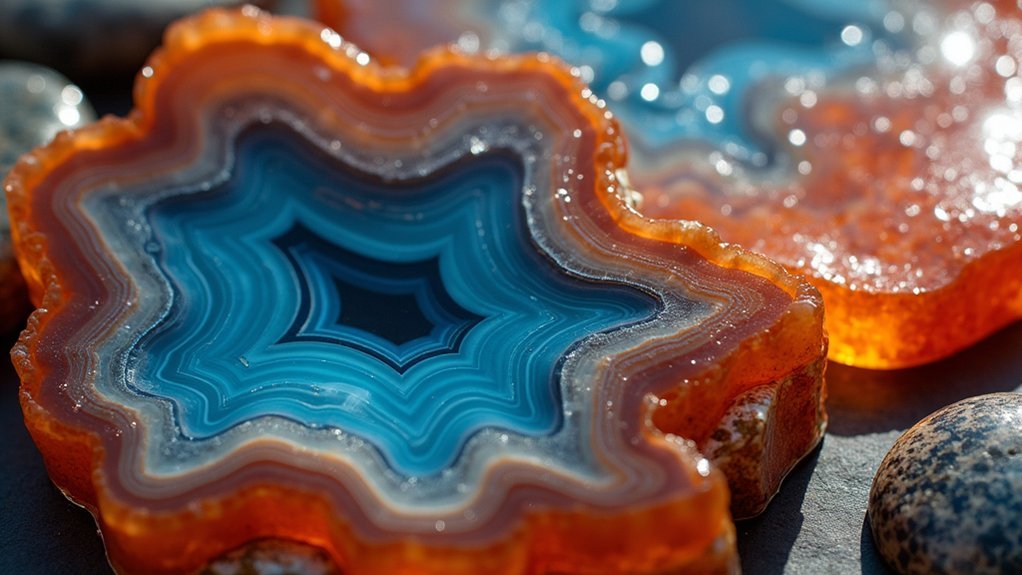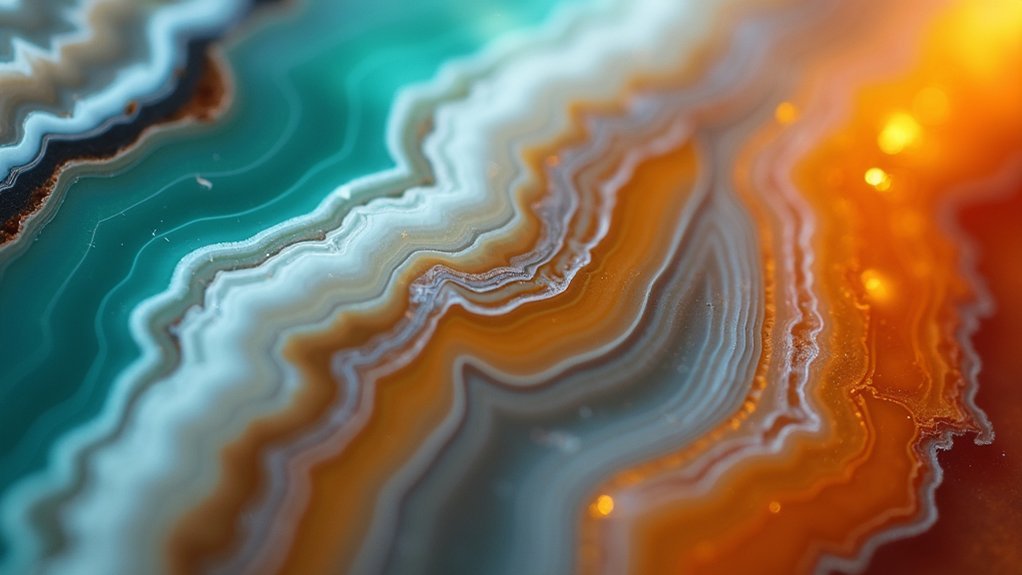You can spot color-treated agate by looking for dye pooling in cracks and fractures, which indicates artificial enhancement. Bright blue agates are typically dyed since natural blue is extremely rare. Check for inconsistent color distribution, unnatural gradients, and overly glossy surfaces that suggest coatings. Use a magnifying glass to examine texture differences and perform a water test to detect bleeding color. Natural agates show gradual color shifts while treated stones display abrupt changes, and exploring these techniques further will sharpen your identification skills.
Understanding Natural Agate Color Formation

When agate forms deep within the Earth’s crust, mineral impurities like iron, manganese, and chromium create its stunning natural colors and distinctive banded patterns.
You’ll notice that natural agate color formation depends heavily on the specific minerals present during crystallization. The formation environment’s temperature and pressure conditions directly influence both color intensity and clarity.
You can identify authentic stones by examining their intricate banded layers, which develop as mineral deposits accumulate over thousands of years.
These natural processes produce agate’s characteristic color range from deep reds to bright yellows and greens. Each stone displays unique variations because no two formation environments are identical.
Understanding this natural agate color formation process helps you distinguish genuine stones from artificially enhanced specimens.
Visual Signs of Dyed Agate Specimens
You’ll notice dyed agate specimens often show telltale signs when you examine them closely for color distribution patterns.
Look for intense color pooling in cracks and fractures, as dyes tend to accumulate in these areas more heavily than the surrounding stone material.
Bright blue agates deserve particular scrutiny since this vivid coloration rarely occurs naturally and typically indicates artificial treatment.
Color Concentration in Cracks
Since dye penetrates through the most vulnerable areas of agate during treatment, you’ll notice concentrated color accumulating in cracks and fissures throughout dyed specimens.
This color concentration in cracks creates telltale signs that distinguish treated stones from natural ones. You’ll observe vibrant hues pooling along fracture lines, creating stark color differences between the crack areas and surrounding stone matrix.
When examining suspected dyed agate, use a magnifying glass to identify these concentrated color deposits.
Natural agate won’t display such dramatic color variations within crack systems. The dye fundamentally follows the path of least resistance, seeping into existing fissures and creating unnaturally intense coloration.
These concentrated areas often appear darker or more saturated than the rest of the stone, providing clear evidence of treatment.
Unnatural Blue Agate Indicators
How can you distinguish naturally occurring blue agate from its artificially enhanced counterparts?
When examining dyed agate, you’ll notice several telltale signs that reveal artificial enhancement. Look for inconsistent color distribution where unnatural gradients appear throughout the stone. Dyed agate typically displays overly vivid or bright blue hues that contrast sharply with natural specimens’ muted, softer tones.
Check the surface finish carefully. If you see a glossy or overly shiny appearance, this might indicate coating or treatment, since untreated agate generally maintains a more natural, matte finish.
Finally, test the specimen under UV light. Dyed agate often exhibits unusual fluorescence patterns that don’t occur in untreated stones, making this an effective identification method for determining authenticity.
Color Concentration Patterns in Treated Stones

When examining agate for potential treatments, color concentration patterns serve as one of the most reliable indicators of artificial enhancement.
You’ll notice dyed stones display concentrated color in cracks or fissures where enhancement solutions collected during treatment. These color concentration patterns appear as vivid streaks or patches that contrast sharply with the stone’s natural hues.
Look for unnatural intensity or uniformity that’s absent in untreated specimens due to natural variations. Uneven color distribution suggests artificial treatment rather than natural formation.
You’ll spot bright, saturated areas within otherwise dull regions, especially in enhanced blues or greens. These concentrated patches create obvious visual inconsistencies that reveal the stone’s treated nature, making identification straightforward once you know what patterns to recognize.
Surface Examination Techniques for Enhancement Detection
You’ll need to examine the agate’s surface closely to detect telltale signs of artificial treatments.
Start by checking for color concentration that pools unnaturally in cracks and fissures, which often indicates dye penetration into the stone’s natural weak points.
Look for any surface coatings or films that create an artificial sheen, as these treatments can mask the stone’s true appearance and alter its natural luster.
Color Concentration in Cracks
Why does color seem to pool unnaturally in certain areas of an agate? When examining agate gemstones, you’ll want to look for concentrated color deposits in cracks, which indicate the stone’s been dyed to enhance its appearance.
This color concentration in cracks is a key identifier of treated gemstones, as natural agate typically displays more uniform coloration without stark contrasts.
Inspect crack edges closely using a loupe or magnifying glass. If you notice more intense color there, it suggests dye was injected during treatment.
Watch for abrupt color shifts at crack boundaries—this unevenness commonly appears in dyed stones rather than natural variations.
You’ll also detect gradient color saturation that’s distinct from untreated specimens, making identification easier.
Surface Coating Detection
How can you tell if an agate’s surface has been artificially enhanced? Start by examining the stone under a microscope to identify inconsistencies or unnatural sheen that reveals surface coatings.
Use a jeweler’s loupe to inspect texture differences—natural agate displays a matte finish while treated stones often appear overly glossy.
Perform a water drop test on the surface. If water beads up instead of soaking in, you’ve likely identified a sealant or coating application.
Look for color banding that changes abruptly or lacks natural variation, indicating superficial enhancement rather than genuine characteristics.
Pay attention to concentrated pigmentation around cracks and edges, which suggests artificial treatment.
These examination techniques help you distinguish between natural agate and stones with applied surface coatings.
Dye Penetration Patterns
Beyond surface coatings, dye penetration creates distinct visual patterns that reveal artificial enhancement in agate specimens.
You’ll notice dye penetration patterns concentrate around cracks and fissures, where colorants seep deeper into the stone’s structure. Use a jeweler’s loupe to examine these areas closely—artificial treatments often create unnatural streaks or lines that natural stones don’t display.
Look for suspiciously uniform coloration throughout the specimen, as genuine agate typically shows irregular color distribution. Dyed stones frequently exhibit more vibrant blues or greens than nature produces.
When examining slabs or cabochons, check the edges carefully. Treated agate may show color only on surfaces, while naturally colored stones maintain consistent hues from surface to core, helping you distinguish authentic specimens from enhanced ones.
Testing Methods for Color Treatment Verification
When examining agate for potential color treatments, you’ll need reliable testing methods to distinguish between natural and artificial coloration.
Start by using a magnifying glass to inspect for concentrated color around cracks and fractures, which typically indicates dyeing. Observe the stone under natural light to identify unnatural color saturation or inconsistencies that suggest treatment.
Perform a simple water test by submerging the agate; if color begins bleeding, it’s likely dyed. Heat-treated stones often display more uniform coloration than their natural counterparts, so look for subtle banding variations that indicate authenticity.
For definitive results, consult a gemological laboratory for advanced spectroscopy testing, which can provide conclusive proof of treatment types and confirm your agate’s natural origin.
Professional Gemological Assessment Options

While basic testing methods can reveal obvious treatments, professional gemological assessments offer the definitive analysis you need for valuable agate specimens. Certified gemologists use specialized equipment like spectroscopes and refractometers to evaluate color and clarity, identifying dyeing treatments through color concentration patterns around surface fractures.
Advanced testing methods, including infrared spectroscopy, detect chemical signatures of treatments such as dyeing or heat enhancement, revealing your gemstone’s complete history.
Infrared spectroscopy reveals hidden chemical signatures from dyeing and heat treatments, uncovering your agate’s complete treatment history.
Professional labs issue certificates detailing treatment status, providing reliable documentation for buyers. You’ll receive definitive proof of your agate’s authenticity and treatment history.
Regular consultations with reputable gemological institutions keep you informed about new treatment techniques and assessment technologies, enhancing your ability to identify treated specimens confidently.
Purchasing Guidelines for Authentic Agate Gemstones
Armed with professional knowledge about agate treatments, you can now make informed purchasing decisions in the marketplace.
When shopping for authentic agates, you’ll want to research sellers thoroughly and request detailed treatment histories. Don’t hesitate to ask for gemological reports that definitively identify common treatments like dyeing or heat enhancement.
Examine stones carefully for telltale signs of artificial enhancement. Natural agates display subtle, varied color distributions, while treated specimens often show overly uniform or intense hues.
Check for concentrated dye in cracks and fractures, particularly in blue agates which are almost certainly treated. Be wary of unnatural shine or excessively bright colors that suggest surface treatments.
Remember that untreated agates command higher values, so investing time in authentication protects your purchase investment.
Frequently Asked Questions
How to Spot Dyed Agate?
You’ll notice dyed agate by its unnaturally vibrant colors, especially blues and greens, concentrated dye in cracks, overly uniform coloring, lack of natural banding irregularities, and excessive glossy shine.
How to Spot Agate?
You’ll spot agate by examining its fine-grained texture and distinctive banded patterns. Look for translucent to opaque stones with vibrant colors ranging from reds to blues, often displaying concentric or parallel bands throughout the mineral.
What Are the Colors of Agate Gemstones?
You’ll find agate gemstones in pure colors like deep red, vibrant blue, lush green, and bright yellow. They also display mixed combinations, banded patterns, and dendritic inclusions creating diverse natural appearances.
What Color Is Natural Agate?
You’ll find natural agate displays subtle earth tones like muted browns, grays, whites, and pale yellows. It features gentle banded patterns with soft color shifts, lacking the vibrant, intense hues seen in treated stones.
In Summary
You’ll protect yourself from purchasing treated stones by applying these identification techniques. Don’t rely solely on visual inspection—combine multiple methods for accurate assessment. When you’re unsure about a specimen’s authenticity, seek professional gemological evaluation. Remember that treated agates aren’t necessarily inferior, but you deserve transparency about any enhancements. Trust your instincts, ask sellers direct questions, and you’ll build a genuine collection you can confidently enjoy.




Leave a Reply